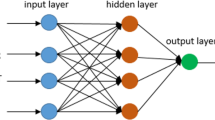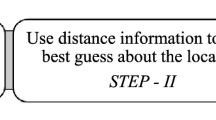Abstract
The energy management problem is an inevitable issue with the wireless sensor network (WSN). There is always a need for an energy-conscious model for WSN that will prolong the network lifetime during system execution. Commonly the WSN is distributed in nature as it is used for several applications like localization, surveillance, and object tracking. In such a scenario, energy management is even more critical. In this regard, we propose an energy-efficient topological localization technique called CLOCK- Localization Approach (CLA) that ensures a long lifetime of WSN by eliminating recurrent reclustering and iterative cluster head (CH) selection. CLA follows a CLOCK pattern-based sensor deployment strategy where the selected CHs play a dual role of CH and Vice-CH. It helps to reduce energy consumption and overhead issue. The simulation result shows that the outperformance of the CLA algorithm in comparison to low-energy adaptive clustering hierarchy-centralized (LEACH-C) and base station controlled dynamic clustering protocol (BCDCP).








Similar content being viewed by others
Change history
20 July 2021
A Correction to this paper has been published: https://doi.org/10.1007/s12065-021-00631-9
References
Rodrigues P, John J (2019) A survey of energy-aware cluster head selection techniques in wireless sensor network. Evol Intel
Dasgupta M, Datta A (2020) On accurate localization of sensor nodes in underwater sensor networks: a doppler shift and modified genetic algorithm based localization technique. Evol Intel
Kuppusamy LA, Zachariah UE (2021) A hybrid approach to energy efficient clustering and routing in wireless sensor networks. Evol Intel
Kumar RA, Hitesh M (2019) Fault tolerance in wsn through pe-leach protocol. IET Wireless Sensor Syst 9(7):358–365
Landge PB, Bhise D, Panda S, Gayen S, Mohapatra H, Rath AK (2020) A comparative analysis of clustering protocols of wireless sensor network. Int J Mech Prod Eng Res Develop (IJMPERD) 10(3):8371–8386
Rath AK, Landge PB, Gayen S, Kumar R, Mohapatra H, Debnath S (2020) An efficient energy saving scheme through sorting technique for wireless sensor network. Int J Emerg Trends Eng Res 8(8):4278–4286
Nayak RK, Tripathy R, Bhise D, Patil SP, Rath AK, Rout SS, Mohapatra H (2020) Smart water solution for monitoring of water usage based on weather condition. Int J Emerg Trends Eng Res 8(9):4278–4286
Rath Amiya Kumar, Mohapatra Hitesh (2019) Fault-tolerant mechanism for wireless sensor network. IET Wireless Sensor Syst
Edalatpanah SA, Kumar Ranjan, Mohapatra Hitesh (2020) Note on optimal path selection approach for fuzzy reliable shortest path problem. J Intell Fuzzy Syst, pp 1–4
Rao MV, Madhav BTP, Krishna J, Devi YU, Anilkumar T, Nadh BP (2019) Csrr-loaded t-shaped mimo antenna for 5g cellular networks and vehicular communications. Int J RF Microwave Comput Aided Eng 29(8):e21799
Yalavarthi UD, Madhav AT, Boddapati TP (2019) Defected ground structured compact mimo antenna with low mutual coupling for automotive communications. Microwave Opt Technol Lett 61(3):794–800
Alzubi S, Kanan T, Elbes, M (2019) A survey on particle swarm optimization with emphasis on engineering and network applications. Evol Intel, pp 113–129
Gao Q, Blow KJ, Holding DJ, Marshall IW, Peng XH (2006) Radio range adjustment for energy efficient wireless sensor networks. Ad Hoc Netw 4(1):75–82
Harris IIIA, F, Stojanovic Milica, Zorzi Michele, (2009) Idle-time energy savings through wake-up modes in underwater acoustic networks. Ad Hoc Netw 7(4):770–777
Abirami T, Anandamurugan S (2016) Data aggregation in wireless sensor network using shuffled frog algorithm. Wirel Pers Commun 90(2):537–549
Kan Z, Hang L, Lei L, Wei X, Jian Q, Xuemin S (2016) Energy-efficient localization and tracking of mobile devices in wireless sensor networks. IEEE Trans Vehicular Technol, p 2
Gautam PR, Kumar S, Verma A, Rashid T, Kumar A (2019) Energy-efficient localization of sensor nodes in wsns using beacons from rotating directional antenna. IEEE Trans Ind Inf 15(11):5827–5836
Rath AK, Mohapatra H (2019) Fault tolerance through energy balanced cluster formation (ebcf) in wsn. In: Smart Innovations in Communication and Computational Sciences, pp 313–321, Singapore, 2019. Springer Singapore
Mohapatra H, Kumar RA (2019) Detection and avoidance of water loss through municipality taps in india by using smart taps and ict. IET Wireless Sensor Syst 9(6):447–457
Rath AK, Mohapatra H (2021) A fault tolerant routing scheme for advanced metering infrastructure: an approach towards smart grid. Cluster Comput
Rath AK, Mohapatra H (2021) Ioe based framework for smart agriculture. J Ambient Intell Human Comput
Xin-Lin H, Fei H, Xiaomin M, Ioannis K, Vukobratovic D (2018) Machine learning for communication performance enhancement. Wirel Commun Mob Comput 3018105(1–3018105):2
Fazio M, Papavassiliou S, Puliafito A, Karyotis V, Pittalà F (2010) Topology-aware hybrid random walk protocols for wireless multihop networks. Lecture Notes of the Institute for Computer Sciences, Social Informatics and Telecommunications Engineering, Mobile Networks and Management, pp 113–129
Kostas Pentikousis, Oliver Blume, Ramón Agüero Calvo, Symeon Papavassiliou (2010) editors. Mobile Networks and Management - First International Conference, MONAMI (2009) Athens, Greece, October 13–14 (2009) Revised Selected Papers, vol 32. Lecture Notes of the Institute for Computer Sciences, Springer, Social Informatics and Telecommunications Engineering
Ratnam DV, Siridhara AL (2019) Multipath mitigation in gps receiver using taylor integrated bidirectional least mean square algorithm. Trans Emerg Telecommun Technol 30(12):e3760
MS, Reddy K, Gunturi SkS (2018) Iot based domestic energy monitoring device. In: 2018 3rd International Conference for Convergence in Technology (I2CT), pp 1–4
Fangxin C, Lejiang G, Chang C (2012) A survey on energy management in the wireless sensor networks. IERI Procedia, 3:60 – 66. 2012 International Conference on Mechanical and Electronics Engineering, September 27-28, 2012 Bangkok, Thailand
Mamun Q (2012) A qualitative comparison of different logical topologies for wireless sensor networks. MDPI Sensor 12(11):14887–14913
Chaitanya R, Shrestha S, Anne. VPK (2019) Iot based smart gas management system. In: 2019 3rd International Conference on Trends in Electronics and Informatics (ICOEI), pp 550–555
Abu-Mahfouz AM, Hancke GP (2017) Alwadha localization algorithm: Yet more energy efficient. IEEE Access 5:6661–6667
Qingzhang C, Dina F, Zhengli W (2010) Design of the energy and distance based clustering protocol in wireless sensor network. In: Yanwen W, Qi L, (eds) High Performance Networking, Computing, Communication Systems, and Mathematical Foundations, Berlin, Heidelberg, pp 8–15
Deng S (2011) Mobility-based clustering protocol for wireless sensor networks with mobile nodes. IET Wireless Sensor Syst 47(8):1–39
Lahari V, Swetha K, Sai KB, Manikrisha GVV (2019) A survey on placement of sensor nodes in deployment of wireless sensor networks. In: 2019 International Conference on Intelligent Sustainable Systems (ICISS), pp 132–139
Sherly L, Annabel P, Murugan K (2012) An energy efficient wakeup schedule and power management algorithm for wireless sensor networks. In: 2012 International Conference on Recent Trends in Information Technology, pp 314–319
Runze W, Naixue X, The LN (2018) An energy-efficient sleep scheduling mechanism with similarity measure for wireless sensor networks. Human Centric Comput Inf Sci 8(1):18
Li H, Liu S, Hu B (sep. 2009) Research on node sleep/wake-up mechanism in wsn based on energy threshold setting. In: 2009 5th International Conference on Wireless Communications, Networking and Mobile Computing, pp 1–4
Dilip K, Aseri TC, Patel RB (2009) Eehc: Energy efficient heterogeneous clustered scheme for wireless sensor networks. Comput Commun 32(4):662–667
Farooq-I-Azam M, Ni Q, Ansari EA (2016) Intelligent energy efficient localization using variable range beacons in industrial wireless sensor networks. IEEE Trans Indust Inf 12(6):2206–2216
Heinzelman W, Chandrakasan A, Balakrishnan H (2002) Energy-efficient communication protocols for wireless microsensor networks. In: Proceedings of the 33rd Hawaaian International Conference on Systems Science (HICSS)
Hassan TAH, Selim G, Sadek R (2015) A novel energy efficient vice cluster head routing protocol in wireless sensor networks. In: 2015 IEEE Seventh International Conference on Intelligent Computing and Information Systems (ICICIS), pp 313–320
Muruganathan SD, Ma DCF, Bhasin RI, Fapojuwo AO (2005) A centralized energy-efficient routing protocol for wireless sensor networks. IEEE Commun Magaz 43(3):S8-13
Author information
Authors and Affiliations
Corresponding author
Additional information
Publisher's Note
Springer Nature remains neutral with regard to jurisdictional claims in published maps and institutional affiliations.
The original online version of this article was revised due to change in co-author’s affiliation.
Rights and permissions
About this article
Cite this article
Mohapatra, H., Rath, A.K., Lenka, R.K. et al. Topological localization approach for efficient energy management of WSN. Evol. Intel. 17, 717–727 (2024). https://doi.org/10.1007/s12065-021-00611-z
Received:
Revised:
Accepted:
Published:
Issue Date:
DOI: https://doi.org/10.1007/s12065-021-00611-z




